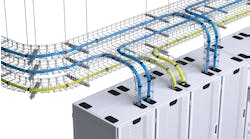Power Outages Beyond Weather: The Changing Energy Landscape
Cities and businesses across the United States are increasingly going dark at the worst moments, creating adverse conditions for critical infrastructure. Although weather is commonly identified as the primary culprit for power outages, several underlying causes also contribute to the growing prevalence of blackouts – aging power infrastructure, malicious hackers, and even physical attacks are also threatening the nation’s energy security.
So what does a stable electrical grid look like? Every minute, the amount of energy being supplied must be sufficient to meet the real-time energy demands of users such as hospitals, families, stores, data centers, and government facilities. To effectively maintain stability, a power grid must be able to respond to sudden voltage and frequency fluctuations caused by such things as equipment malfunction, human error, and load increases. However, the rise of renewable energy sources has caused a shift in the country’s energy landscape, introducing new variables that impact grid stability and increase outage risks.
Impact of renewable energy on the grid
When generating electricity using solar or wind power, even expected fluctuations can cause grid instability. Wastage happens when the supply from these renewables is abundant, such as on a sunny or windy day, but grid operators cannot adequately store the energy that is being generated. Utilities and grid operators relying on renewable energy sources require additional measures to ensure stability, while customers need protection in the event of interruptions that may stem from severe weather or a mismatch of energy supply and demand on the grid, leading to controlled outages.
Aging infrastructure: The root cause
Our aging power infrastructure is a significant factor in the number of outages experienced each year. Much of the country’s energy grid was built decades ago and is now reaching its expiration date. Additionally, certain regions have insufficient infrastructure to handle the changing ways power is produced and consumed.
As power grids and distribution systems age, they become more vulnerable to failures and breakdowns, leading to disruptions in the supply of electricity. Outdated facilities, worn-out transmission equipment, and insufficient maintenance exacerbate the problem. To address this issue, urgent investments and comprehensive modernization efforts are required to upgrade and strengthen the aging energy infrastructure.
Infrastructure retirement
Coal has been a reliable energy source for more than a century, but it is now being phased out due to environmental concerns and the availability of cheaper renewable options. While retirements have improved air and carbon emissions, the process has also created a void in our energy supply. As these outdated power plants shut down, natural gas, wind, and solar energy supplies have stepped in to take their place.
This transition has been challenging. As a result, utility companies must find new ways to meet their customers’ energy demands. With coal being such a significant power source in many regions, there are fears that the transition could lead to blackouts and energy shortages. However, this transition can be effectively managed with careful planning and investment in a mix of dispatchable and renewable energy infrastructure, ensuring a reliable and sustainable energy supply for the future.
Hacking the grid
Malicious actors, such as hackers and state-sponsored groups, can exploit weaknesses in critical infrastructure systems to gain unauthorized access and disrupt power supply. These threats can take various forms, including physical attacks, distributed denial-of-service attacks, ransomware attacks, and sophisticated malware infiltrations. The risk is exacerbated by vulnerabilities in outdated software, inadequate network and physical security measures, and insufficient employee training. When successful, these attacks can shut down the power infrastructure for days or weeks, resulting in widespread blackouts, financial losses, and potential disruptions to essential services.
To mitigate these risks, robust cybersecurity strategies, continuous monitoring, prompt patching of vulnerabilities, and increased collaboration between energy companies and security agencies are essential. Additionally, a fundamental incident response plan can outline how to respond quickly and effectively if an attack should occur. By proactively building strong cybersecurity measures, utilities can better protect vital systems from cyberattacks and minimize the impact of any security breach. Yet, the risk remains a constant threat.
Providing reliable power during times of unreliability
Regardless of the reason for disruption, communities and businesses are seeking confidence in their power supplies during unplanned outages caused by these many hazards. On-site energy resources have long been key to ensuring access to uninterrupted power, but what if those solutions could help stabilize the grid in addition to keeping operations up and running?
Dual-purpose microgrids, fueled by clean-burning natural gas and renewable natural gas, are the foundation of Enchanted Rock’s resiliency-as-a-service. As an alternative to traditional diesel backup power, Enchanted Rock microgrids are meticulously maintained and monitored to provide fast, reliable response when grid power becomes unstable or is outright unavailable. When backup power isn’t required, the microgrids can supply capacity back to the grid without disrupting normal operations.
To manage risks, facilities such as data centers, which cannot tolerate outages, are benefitting from technologies such as Enchanted Rock’s predictive analytics and automated control systems. These technologies can better anticipate the status of the grid, reacting quickly to any unplanned events. With this knowledge, facilities can prepare by utilizing microgrids that supply the energy needed, independent of the grid.
Through our resiliency-as-a-service program, customers can easily monitor their energy usage, stay informed on potential outages, and have peace of mind during a variety of challenging events.
Brian Jabeck is Vice President of Data Centers at Enchanted Rock. Contact them to learn more about their natural gas microgrid solutions.






